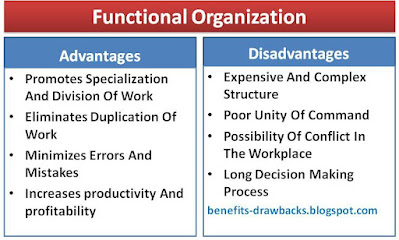What Is Functional Organization ?
Functional organization is highly specialized structure in which organizational functions are divided into smaller group and different departments (such as production department, sales department, IT department, human resource department, finance department, research and development department etc.) are created to perform different activities. Each department is managed, supervised and controlled by highly skilled and capable departmental head or manager.
Benefits Or Advantages Of Functional Organizational Structure
The main advantages of functional structure can be described as follows:
1. Proper Work Division
In this structure, organizational functions are divided into small groups and assigned to different units and departments. Highly skilled and qualified departmental heads and employees are selected to perform the tasks which helps to increase the performance and output.
2. Encourages Specialization
In functional organizational structure, various departments are created to bring specialization in the workplace. Each department consists or specialist and and expert manager and qualified subordinates. Specialization helps to increase efficiency and productivity.
3. Large Scale Production
Because of division of work and specialization, operational speed will be increased which facilitates mass production. Large scale production minimizes the cost of production.
4. More Profit
Specialization helps to minimize errors and wastage in the production process. Large scale production lowers the cost of production. Decrease in wastage and cost leads to increase in the earning of the organization.
5. No Duplication Of Work
Organizational tasks are segregated properly and allocated to the related departments or units which helps to eliminate the duplication of work.
6. Better Control And Supervision
Functional organizational structure follows decentralization in which supervision and controlling activities are done by both departmental managers and top manager. So, proper discipline can be maintained in the organization.
7. Relief To The Management
Operational activities are handled, supervised and monitored by the departmental heads. So, workload of top level management is reduced and they can utilize time in other important activities such as planning and policy making.
8. Flexibility
Functional structure is more flexible than other types of organizations. Changes can be made as per the requirement without disturbing other organizational activities.
Drawbacks Or Disadvantages Of Functional Organization
The main disadvantages of functional organization can be described as follows:
1. Complex And Expensive Structure
One of the main drawbacks of functional structure is that it is more complex and difficult to understand. It requires huge investment to form this type of organization. Higher remuneration for specialists and experts increases the operating expenses. Therefore, it is complex and costlier than line structure and line and staff organization.
Also Read:
Advantages And Disadvantages Of Line And Staff Organization
Advantages And Disadvantages Of Matrix Organization
Advantages And Disadvantages Of Committee Organization
2. Not Suitable
Because of complexity and requirement of more investment, this design is not suitable for small and medium sized organization having less resources.
3. Possibility Of Conflict
There is a chance of conflict between departments because of the lack of proper communication and poor coordination.
4. Poor Unity Of Command
Because of multiple command system, employees are accountable for number of supervisors which may lead to poor unity of command. In this situation, it is difficult to maintain proper control and discipline in the organization.
5. Delayed Decisions
In functional organization, quick decision is not possible because top management should consult with various departmental heads and specialists to make any decision. So , organization may have to face difficulties at the time of emergency when prompt decision is required.
Pros:
- It promotes specialization and division of work
- Workload of top management is reduced
- It improves the performance, productivity and profitability
- There will be no duplication of works
- It reduces mistakes and errors
- It is flexible in nature
- There is a greater scope of expansion
- It is suitable for big manufacturing organizations
Cons:
- It is complex, expensive and resource consuming structure
- It is not suitable for small firms and non-manufacturing organizations
- Quick decisions cannot be made at the time of emergency
- High chance of conflict due to the lack of proper communication and coordination
- It ignores the principle of unity of command





